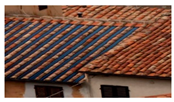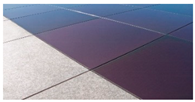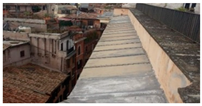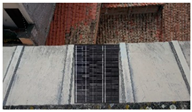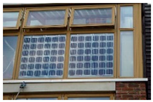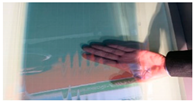Abstract
In this work, we investigate the potential of using last generation photovoltaic systems in traditional building components of historical buildings. The multifunctional photovoltaic components also open new application and implementation horizons in the field of energy retrofitting in historical buildings. Some of the Building-Integrated Photovoltaics (BIPV) solutions lend themselves optimally to solving the problems of energy efficiency in historical buildings. For the next few years, Italian legislation foresees increasing percentages of energy production from renewable sources, including historical buildings. The opportunities and constraints analysed are presented through a specific approach, typical of building processes for innovative technological BIPV solutions on historical buildings.
1. Introduction
The heritage building stock of which Italy is particularly rich must be studied with an innovative approach for acceptable energy retrofitting solutions. In historical buildings, energy efficiency requirements, in synergy with conservation and protection, show methodological and operational limits that cannot be generalized.
Decarbonization policies framed by the European Union (EU) in the emissions reduction roadmap involve all the economic sectors, such as the civil and construction sector that includes heritage building stock [1]. The need to reduce the incidence of emissions in this sector has stimulated European legislators and international research centres to reduce energy requirements using nearly Zero Energy Building (nZEB) solutions [2,3,4,5,6,7].
The International Energy Agency (IEA) attributes over 40% savings in expected heating and cooling energy demands under a low-carbon scenario directly to improvements in the building envelope [8].
Driven by policies towards Zero-Energy Buildings and subsequently Plus Energy Buildings (PEB), design and innovation with new Building-Integrated Photovoltaic (BIPV) materials, concepts and combinations of energy-efficient building materials, with BIPV have become essential parts of the development strategies of both, the photovoltaic (PV) sector and the building sector [9,10,11].
The Strategic Energy Technology Plan (SET Plan) defines renewable technologies as being at the heart of the new energy system, with photovoltaic solar energy as the main pillar [12].
The heritage building stock can provide a contribution to decarbonization policies using Renewable Energy solutions (RES) installed on the building envelope with BIPV appropriate solutions. Most of the Italian heritage building stock does not present stringent protection restrictions as required by current regulations [13]. They can be classified as Traditional Historical Buildings (THB) that are not directly included in the Maintenance and Restoration category of the Code of Cultural and Landscape Heritage [14]. The historical importance of the building is herein regarded in the function of the specific Italian post-unification period (1871–1942). Urban design, building types, construction techniques and the technology of the material used are not included in any category of particular interest or value to guarantee its safeguarding as foreseen by Cultural Heritage codes. In Rome, over 50% of the existing building stock falls under THB. In Europe, architectural and planning regulations for protected historical buildings lead to major technical constraints in integrating renewable energy, such as photovoltaics. These problems call for innovative and creative solutions for BIPV that must apply both aesthetic and photovoltaic technology to historical buildings that represent the artistic and cultural heritage of a city.
The Energy Performance of Buildings Directive (EPBD) prescribes the Member States to increase the number of buildings that not only fulfil current minimum energy performance requirements, but are also more energy-efficient, thereby, reducing both energy consumption and carbon dioxide emissions [15,16].
In Italy, Ministerial Decree 26 June 2015 completes the transposition of the European EPBD 2002/91/EC. This legislative measure comprises: (a) the application of calculation methodologies for energy performance and the definition of the minimum requirements for buildings; (b) requirements of nearly zero energy buildings; (c) sets the new minimum Energy Performance EP; (d) defines single component requirements to enter into force starting October 2015 [17].
Historical buildings represent a good reference paradigm by which we can investigate energy retrofit approaches and methodologies using BIPV solutions [18].
It is more difficult to apply an adequate retrofitting scheme on historic and/or listed public buildings, particularly in Italy, because there are strict regulations on the changes of this type of building. In the case of Rome, solar energy harvesting in Italian urban scenarios were analysed, by considering the geographical and morphological constraints with respect to the Sustainable Energy Action Plans (SEAP) [19].
The production of energy with solar systems as well as depending on local radiation is highly conditioned by the solar conversion technology adopted and the orientation of the modules. These factors are even more stringent on THB, as not all optimal exposures can be used for mounting modules due to the magnitude of impact. The THBs considered in this work can be assimilated to the provisions of the Annex 3A-B for the Built Heritage or Historic Urban Landscape of the International Council on Monuments and Sites ICOMOS Guidelines, where a grading scale for assessing the value and magnitude of the impact of Heritage assets is proposed. ICOMOS Guidance on Heritage Impact Assessments for Cultural World Heritage Properties [20,21].
In relation to the public heritage building stocks, it is possible to identify thresholds beyond which nZEB targeted non-reachability allows for a more defined vision of the issues, and to implement specific retrofitting strategies [22].
The requirements in the improvement of energy efficiency in cultural heritage buildings using active solar systems in historical constructions establishes the use of the general principles of restoration, including the reversibility and non-invasiveness of interventions on historical structures [23]. This approach can also be reworked for interventions on THBs, as illustrated below, starting from a holistic point of view and by examining the relationship between energy efficiency and preservation of the THB. This approach can also be reworked for interventions on THBs as illustrated below. PV technology in architecture has two types of solutions: Building Attached Photovoltaics (BAPV), in which the element is mounted on the casing using various techniques; and BIPV modules that form a building component and provide a function as described in EU regulation 305/2011, that defines the seven basic requirements for construction that have to be fulfilled, in addition to the electrical requirements [24]. PV Active Solar components are also defined as multifunctional as they must simultaneously perform functions so that the active architectural element of the building system produces and distributes energy [25,26,27]. In addition to being a source of electricity, several other purposes can be achieved, such as weather protection, thermal insulation, noise reduction and daylight modulation.
In recent years, BIPV applications in Europe have been applied to one-third of all renovation projects and two-thirds of new building construction [28]. The photovoltaic productivity on roofs and façades in Europe was estimated at around 1 TWp by 2030 [29]. For integrated solutions like BIPV, it has been calculated that Italy can reach 40% of the national electricity needs [30,31,32]. BIPV is a solution that can be adapted to the historical building stock to satisfy solutions calibrated on these particular buildings. When changes and adaptations to sustainability standards are proposed, even the slightest alterations, particularly external, can be damaging [33]. BIPV Solutions should be assessed as opportunities in the energy efficiency processes of historical buildings. At the same time, constraints must be assessed to mitigate the risks of impact on architectural and landscape heritage of merit and value.
The major problem of BIPV on THB solutions is the visual impact determined by the color of the photovoltaic cells that affect the level of the overall insertion on valuable casings and traditional materials. The color of a solar module is determined by the color of the cells in the module. [34]. Layering techniques to camouflage the PV element and solar damage to traditional materials, such as brick, tile and plaster developed in nanoscale, are in an advanced phase of the study and solutions are already on the market [35].
BIPV applications with high integration and almost no visual impact are already on the market [36]. Solutions for the treatment of glazed surfaces, Window-Integrated Photovoltaics (WIPV), with nanotechnologies are also very interesting [37]. The colored glass is selective, designed to reflect a narrow spectral band of visible light to provide color. The rest of the solar spectrum is transmitted to the solar device and converted into energy.
This duality in a historical building clearly influences the evaluation of materials and technologies, restricting solutions first and foremost to the aesthetic factor. The visual impact component conditions the materiality of the element that is firmly correlated to the materials with which they are made.
In this work, we want to investigate the opportunities and constraints of BIPV solutions in historical buildings, evaluate the potential applications in the regeneration of historical and/or traditional building heritage, without detriment to conservation and protection. Three macro-factors, technologies, market, and innovative solar-integrated solutions that describe state-of-the-art BIPV are analyzed beforehand. A final evaluation scheme of the opportunities and constraints of BIPV solutions on historical building enclosures is then proposed.
Then, a synthesis approach is defined to meet the needs of the energy retrofit, the protection and preservation of the historical building stock and the BIPV solutions, named Heritage Building Energy Solar Solution Technologies (hBESST).
The typical structuring modalities of the BIM-based building design process [38,39,40] and the correlations with BIPV solutions on historical buildings will be briefly analyzed.
2. Materials and Methods
2.1. Historical Buildings and Traditional Heritage Buildings (THB) Retrofitting
The relation between sustainability and heritage cannot be reduced to the mere energy efficiency of the buildings, simplifying a complex problem into an exclusive element of energy savings [41].
In Italy, over 7 million buildings are over 50 years old, which is equal to 61% of the building stock. From these, over 2 million, or 18%, are in a state of conservation ranging from mediocre to bad. The planned objectives of greenhouse gas (GHG) reduction in the construction sector, introduced by international and national regulations, must be compared to find economically sustainable solutions for each type of user.
The guidelines for improving energy efficiency in cultural heritage indicate that no solution can be considered in itself decisive and that the perspective, in which to move, can only be that which pragmatically proceeds on a case-by-case basis. The current approach is to reduce visual impact, using shields which obstruct the view of the modules to obtain a low magnitude of impact [21,42]. However, the approach cannot be simply one of concealment. Layering technologies allow overlapping layers, of which the last one is visible, made with finishes similar to historical and traditional building materials that hide the underlying photovoltaic element [43].
In principle, multi-layering techniques modify the appearance of a solar cell through the variation of the Anti-Reflection Coatings ARC [44]. The placement of stacks with large numbers of layers is a challenge, especially in a high-throughput, low-cost production environment [34].
The processes used in manufacturing the new transparent PVs are environmentally friendly and not energy-intensive. The coatings are placed at nearly room temperature so the transparent PV can be laid on essentially any type of surface [45]. There is no need to use glass, which is costly in the manufacturing of conventional systems [46].
All Italian historical building stock, bound and not, will be increasingly subject to interventions of energy retrofitting in the coming years. In Italy, Legislative amendment 28 of 2011 in the implementation of Directive 20-20-20 (2009/28/EC) introduced the requirements for renewables in buildings (RES) in the event of major renovations. Regarding buildings that fall into the category of historical centres, as defined by the legislation [13], the percentage of RES coverage is expected to be 25% starting on 1 January 2018. It can also be obtained through technological combinations.
In the building sector, photovoltaic technology has taken over as a low-level integration technology element, with installations, usually adhering to the enclosure, known as Building Attached Photovoltaic (BAPV) [47,48].
The problems of technology and protection integration are addressed as follows: “doing something about historical buildings with energy efficiency measures (obviously compatible with the cultural characteristics of the artefacts) is the first significant step for the real conservation of said heritage, so widespread, so fragile, so difficult and expensive to preserve [49].” In historical buildings, listed and not, the installation of photovoltaic systems and components has always had to deal with the visual impact on traditional materials and urban and landscape contexts.
The production of electricity from photovoltaic sources is one of the technological solutions that can be integrated into the building with plug and play solutions. In geographical areas, such as Southern Europe, the annual productivity in the face of well-exposed available surfaces allows for the coverage of high levels of electricity requirements: see Figure 1.
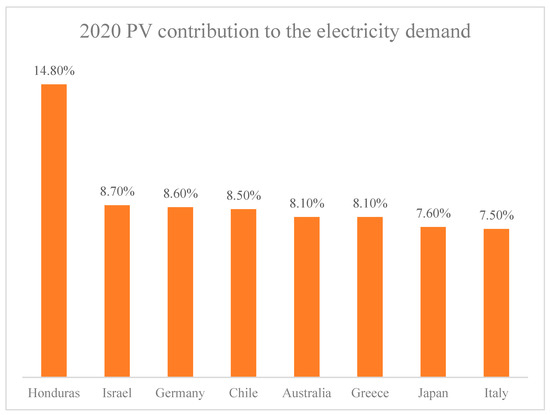
Figure 1.
Theoretical PV production by nation (Source: 2018 snapshot of Global Markets—IEA PVPS).
Energy THB retrofitting with BIPV solutions has been an important subject in an R and D laboratory of ideas, which are developed to create solutions for the support and guardianship of the architectural property [50,51,52,53].
The increase in the production of electricity from solar sources is constantly on the rise thanks to progressively improved high-performance materials and technologies [54,55]. The active surfaces on the building envelopes, using efficient materials and technologies, will allow for an increase in the density of electricity from solar sources to single buildings, and in the single exposed surface of the casing. The energy density factor in BIPV is decisive in the choice of photovoltaic technologies to optimize the available surfaces concerning the production of electricity, as shown in Figure 2 [56,57,58].

Figure 2.
Power density (W/m2) BIPV modules by the installation.
The use of integrated low visual impact solutions and the increased availability of electricity from RES will permit the use of the primary energy from the sun for the production of electricity with H2G (Hydrogen to Gas) hybrid solutions [59,60] and the possibility of achieving the objectives set for nZEBs.
The energy response (using a network of active and passive systems and technologies) from a historical building (or a “cultural landscape”, using due caution in terminology), can be improved through appropriate and well-balanced solutions [61].
Plant components have become an increasingly invasive part of the building-plant system since the Second World War [62,63]. Moreover, historical buildings have undergone the highest number of (sometimes damaging) alterations due to the inclusion of new plant solutions over the years as per Figure 3.
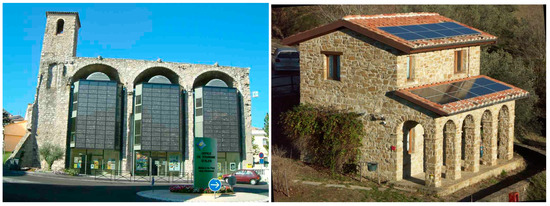
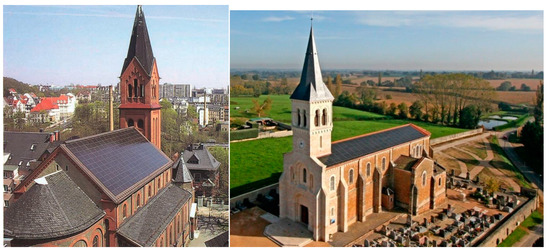
Figure 3.
Implementation of somewhat controversial photovoltaic systems on heritage buildings.
Technological infrastructures require technical spaces such as cavedium, traces, and niches that are often obtained without preliminary studies on stone and/or masonry bearing structures. Historical heritage in real estate, as buildings, must always be able to testify to their historical importance through all the material components that constitute it. Conservation can be implemented to all the activities and work carried out to control the conditions of the cultural property and maintain the integrity, functional efficiency and identity of the property and its parts [13] through appropriate maintenance methods.
With a view to an integrated process between HB retrofitting and solar energy solutions like BIPV, Heritage Building Information Modeling (HBIM) can offer solutions that allow framing information flows and critical factors. The application of BIM design process to existing buildings it will become mandatory in the coming years for all types of design especially in regards to maintenance and large refurbishments [40,64,65], but these applications do not contemplate the historical and cultural legacy of the buildings and sites [66].
The BIM approach is a ‘workflow’, in which all of the building objects that combine to make up the building design coexist in a single database. This concept is important because it allows us to understand the entire building lifecycle (encompassing design, build and operation) from a single, central data storage unit. Therefore, in theory, a BIM implementation should facilitate a single, logical, consistent source of information associated with the building.
The definition of Level of Definition (LOD) within the workflow aimed at the HBIM, and specifically the PV components, is the first methodological step to be implemented. One of the first objectives in developing a BIM model of infrastructure is to define its LOD. Design phase outputs require a very detailed definition of project components to enable the user to extract automatic configurations of element quantities and related costs, and also to generate two-dimensional (2D) technical drawings [67].
There are still gaps in the know-how that forestall insights into the future development of methods and tools of Historical Building Information Modelling for refurbishment projects. Therefore, it will prevent a complete automated diagnosis of the residual performances and designs of energy retrofitting using BIPV solutions.
In this work, we present a series of fundamental elements for energy retrofitting interventions on THBs that are strongly integrated with each other. The process presented requires active involvement of the stakeholders. The innovations in the design process of the BIM-HBIM is transformation in all this phases throughout the entire process: Design, management, maintenance, decommissioning. The multi- or trans-disciplinarily that governs energy retrofitting is even wider in the case of Built heritage or Historic Urban Landscape.
For the above mentioned, and, this paper proposes a holistic approach to the entire design process starting from the assessment of the conservative impact in relation to BIPV energy efficiency solutions on Built Heritage. This approach is presented with a preliminary integrated assessment of the benefits for energy efficiency, heritage impact and intervention costs of, highlighting opportunities and constraints.
2.2. BIPV Standardization
The concept of a multi-functionality for a photovoltaic module poses a problem shared definition between technological or construction component.
It is important to remember that any use of PV modules must adhere to the specific standards in force in the country of use. The European standard EN 50583 for BIPV that applies to photovoltaic modules used as construction products, was published in 2016. This new standard consists mainly of the compilation and modification of existing standards related to BIPV. To be suitable for building integration, PV products must fulfil both the standards of the PV sector and the construction sector as presented in Table 1 [11,68].

Table 1.
Electrical and building reference standards for PV modules [69].
The scope of EN 50583 is to implement technical requirements for photovoltaic modules used as building components that are subjected to both electrical standards; the Low Voltage Directives 2006/95/EC and IEC/CENELEC, and the European Construction Product Regulation 305/2011 [70].
The standard is divided into two parts: (1) Photovoltaics in buildings: Panels, two-part systems, based on three levels of differentiation as reported in Table 2:

Table 2.
Levels of differentiations EN 50583.
Until the norm EN 50583-1/2 “Photovoltaics in Buildings” was published, BIPV modules and systems were not regulated through any unified European standard. PV panels mounted on the building envelope in either, one of the five mounting categories, stated in the EN 50583 standard, were thus treated both as an electrical component and a building product. However, the EN 50583 standard does not focus largely on BIPV modules. They are mentioned briefly in part 1 with regards to categorization dependent on the material (glass/polymer/metal sheet/other), and in part 2, with regards to categorization dependent on the installation method.
To be suitable for building integration, PV products have to fulfil both the PV sector and construction sector standards. Most of the time, the requirements for these standards are related to a country or a region [68].
In Italy, a definition of BIPV is given by the GSE Gestore Servizi Energetici (Energy Service Management). The photovoltaic model that is possible and effective for applications of an architectural type alone, is the building element itself [71]. This document extends particular relevance to the concept of integration for which the photovoltaic surface, together with the assembly system (in the case of a special component), replaces traditional building elements, and in addition to the production of electricity, guarantees the following functions typical of a building envelope: Water tightness, mechanical seal comparable with that of the replaced building element, and thermal resistance that does not compromise the performance of the building casing.
Building-Integrated Photovoltaics is classified as a new building system technology drive as established in the UNI 8290 standard [25]. The problem of the classification of photovoltaic models to be supplemented in the covering of a building has also been described from a fire protection perspective. This has highlighted a normative gap in all PV systems not recognized as construction products. This was dealt with in EN 15583.
A shared definition of the solutions for the integration of photovoltaic technologies on the building envelope are the following:
- BAPV: Photovoltaic modules are considered to be building attached if the PV modules are mounted on a building envelope and do not fulfil the above criteria for building integration.
- BIPV: Building-Integrated Photovoltaics modules are considered to be building-integrated if the PV modules from a construction product providing a function as defined in the European Construction Product Regulation CPR 305/2011. Thus, the BIPV module is a prerequisite for the integrity of building functionality. If the integrated PV module is dismounted (in the case of structurally bonded modules, dismounting includes the adjacent construction product), the PV modules would have to be replaced by an appropriate construction product.
The action of harmonizing CENELEC and ISO regulations is the subject of a study conducted by the IEA Pvps Task 15 to subtask C to achieve:
- The international definition of BIPV
- BIPV needs and functions analysis
- BIPV requirements overview
- Multifunctional BIPV evaluation
- Suggested topics for exchange between different standardization activities on an international level.
The work on BIPV standardization has gained new impetus due to the decision by IEC/TC 82 to create a new Project Team (PT 63092) to prepare an international BIPV standard [72].
Building-Integrated Photovoltaics on historical buildings is an approach that must take into account the peculiarities of traditional materials and visual impact in a logic of high integration and reversibility.
2.3. Three Macro Factors for Building-Integrated Photovoltaics
The reduction of consumption and the consequent lowering of the energy requirement is chosen based on high-efficiency plant elements.
The adoption of multifunctional BIPV innovative solutions and colored active PV components with high energy efficiency will allow remedying, or at least mitigate, the historical conflict between technological systems and the safeguarding and protection of the Architectural historical building.
Three factors determine favorable conditions for the development of BIPV as illustrated in Table 3: Technology, market and innovative solar-integrated technologies. The first two can be measured and evaluated directly. The third factor must be assessed by less deterministic formalities through a Building Management Approach for Heritage (BMAH). The first two are exogenous factors independent of the historical importance or otherwise the building and materials with which it was built. The third one must be analyzed with all its components. This analysis can be conducted through a case-by-case approach, but with a holistic methodology that respects the valorization and historical building energy retrofit.

Table 3.
Macro factors of BIPV on historical buildings.
In constrained or THB buildings, BIPV is the bottom-up approach. The building process is based on inductive reasoning: from specific to universal, through analyses and solutions that must be adopted using an innovative methodology.
The three factors listed above are analyzed individually, highlighting their significance in the case of BIPV on heritage buildings.
2.3.1. Photovoltaic Technologies
Research in the PV field still focuses greatly on silicon-based materials. Since no single technology, either established or in development, offers benefits on all fronts, researchers recommend scaling up current silicon-based systems quickly. While, continuing to work on other technologies to increase efficiency, decrease materials used, and reduce the manufacturing complexity and cost [45]. PV classification is arranged by generations on the grounds of the evolution of the technologies [73]:
- I Generation: Silicon-based solar cells (mono- and poly-crystalline silicon) constituted the first PV sector to emerge. Currently, crystalline silicon technologies account for more than 97% of the overall cell production and more than 94% in the IEA PVPS countries [8].
- II Generation: Thin-film solar cells based on CdTe, copper indium gallium selenide (CIGS), or amorphous silicon was developed as a cheaper alternative to crystalline silicon cells.
- III generation’ solar cells (tandem, perovskite, dye-sensitized, organic, new concepts, …) account for a broad spectrum of concepts, ranging from low-cost low-efficiency systems (dye-sensitized, organic solar cells) to high-cost high-efficiency systems (III–V multifunction), with various purposes from building integration to space applications [8,59,74,75,76].
Emerging technologies encompass advanced thin films and organic solar cells (OSC). The latter is about to enter the market through niche applications.
- Concentrator technologies (CPV) use an optical concentrator system, which focuses solar radiation onto a small high-efficiency cell.
- Multi-junction cells design involves superposing several cells in a stack [75].
- Novel PV concepts aim at achieving ultra-high efficiency solar cells using advanced materials and new conversion concepts and processes [8]. The flexibility and light weight make them useful for nomad applications, while the possibility to tune the color, the shape, and the transparency opens the route of the integration in modern and esthetic features [73,76].
- Glazing integrated photovoltaics based on dye-sensitized solar cells are in a relatively early stage of development. These solutions are very interesting for installations on glazed surfaces for any type of building, historical or otherwise, as they preserve the aesthetic appearance of the enclosure. The colour scale available offers designers greater choice [77].
Table 4 shows the targets foreseen by the Technology Roadmap for photovoltaics up to 2050.

Table 4.
General technology target (Source: Technology Roadmap, solar photovoltaic energy, IEA 2010).
For the next few years, Crystalline Technologies will still represent a reference point, given their significant presence of maturity and technology on the market.
The main objectives of research on photovoltaic technologies are:
- Increase module efficiencies
- Reduce Si consumption
- Develop specific PV materials/solutions for building integration.
- Low energy-intensive production processes
- Readily available raw materials
Many studies are addressing the need to synthesize BIPV solutions with nZEB references, highlighting that each new intervention, including energy efficiency, has to maintain the values mentioned, and further achieve suitable landscape integration within the urban context [7,78,79,80,81].
The availability of primary energy from PV provides a fundamental contribution to the net-zero energy balance that can be determined, either from the balance between delivered and exported energy or between load and generation. Import and export balance and the latter load/generation balance [82,83].
National strategies towards climate-neutral buildings have to reflect the (future) climate, the building standard and energy system as well as the associated (future) energy grid infrastructure. Individual strategies differ depending on the climate, the resources for renewable power in the grid and the heating and cooling grid infrastructures but they must keep in mind development towards a more networked European energy grid in the future (smart European grid) [4].
The visual impact of BIPV is a problem that encounters more difficulties in the solution due to the synthesis of issues to be addressed within the photovoltaic architecture of valuable envelopes. In the present work we provide a multidisciplinary approach that is considered unavoidable as a result of the convergence of issues regarding antithetical appearance.
2.3.2. The Market
The cost of photovoltaic technologies is constantly changing. By 2025, the global weighted average levelized cost of electricity (LCOE) of solar photovoltaics (PV) could fall as much as 59% [55]. Moreover, together with the achievement of Grid Parity in Italy [78], they are a valid driver for the energy efficiency of the historical building stock [78,79,84,85].
Building-Integrated Photovoltaics is seen as one of the five major tracks for large market penetration of PV, in addition to price decrease, efficiency improvement, lifespan, and electricity storage [86].
The increase is justified through the rapidly plunging installation cost per watt; enhanced aesthetics of BIPV; improving the efficiency of c-Si modules as well as flexible thin-film panels, and the unabated desire among residential and commercial owners to “go green” and to reach the national energy efficiency target [87].
Building-Integrated Photovoltaics is still too costly, especially when compared to its rival technology, building-added PV (BAPV) since its added value as a multifunctional building element is only now beginning to be recognized [88].
It is expected that the BIPV/BAPV prize will induce the integration of new photovoltaic systems in protected historical urban districts by accelerating innovations in photovoltaic technologies and improving the architectural enhancement needed for sustainable use in European protected historical urban districts [89].
The growth opportunities for the BIPV market analyzed by the NREL [90,91,92] for the residential sector, are among the factors to be enhanced in the future through government support in maintaining historical/cultural building designs and through incentives.
The levelized cost of energy (LCOE) from PV systems is already below retail electricity prices (per-kWh charge) in several countries [93]. Innovations in the solar technologies field, with more and more politically efficient and appearance incentives, have introduced the Grid Parity including an LCOE between 200-300 USD/MWh in Italy.
LCOE of PV and BIPV are different. From 2010 to 2018 the BAPV LCOE in Italy suffered an 80% drop [94].
At the basis of this reduction is obviously 26% to 32% the drop-in prices of crystalline silicon modules. BIPV lowering of the LCOE is related to the reduction of costs in project management, due to the strong integration of BIPV in the building project, design and construction and performance cost reductions of technological components. For example, some savings derive from the elimination of the cost of BIPV mounting hardware.
The Energy Pay Back Time (EPBT) is the time it takes for the PV system to generate as much energy as has been used to produce it. High energy return on energy investment (EROI) corresponds to a short EPBT as reported in Table 5.

Table 5.
Mean harmonized EPBT and EROI for multiple insulations in the Italian area.
An EPBT of one year and a life expectancy of 30 years corresponds to EROI of 30:1 [8]. EROI is simply a measure of the marginal amount of additional energy that certain technologies can provide in society for a given energy investment [95,96]. In the following table, the results of research, conducted in the systematic review, are re-established and meta-analysis of embedded energy, energy payback time and energy return on energy invested for the crystalline silicon and thin-film photovoltaic systems [97]. The results highlight, depends primarily on their embedded energy and not their efficiency.
The following table, elaborated by the author on data from Defne et al. [97,98], shows the relative results given the mean harmonized EPBT values for the following insolation (kWh/m2/yr): 1700 (Italian average), 1436 (Central Italy), and 2032 (Sicily in Southern Italy) for roof mounted PV.
A PV system with a multicrystalline module in Sicily has an EPBT of around one year. Considering a lifespan of 20 years this system can produce twenty times the energy needed to produce it [99,100].
2.3.3. Innovative Solar-Integrated Technologies
Low impact integration on traditional elements of historical buildings, following the innovations on the single photovoltaic cells, opens new perspectives with important repercussions for the valorization and protection of the historical building heritage.
The innovative BIPV solutions rely on the multifunctional qualities that determine the level of integration on building envelopes, be they modern or historical [86,91,92,99,100]. The two factors define a specific “Photovoltaic architecture” approach as proposed by Antec Solar in Figure 4.
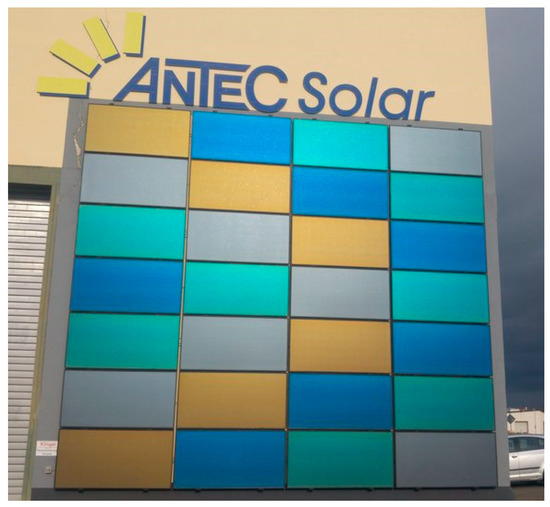
Figure 4.
Multi-color solar wall Antec Solar headquarters in Arnstad Germany (source: [37]).
Photovoltaic architecture is a discipline called to find innovative, energy sustainable solutions with a low magnitude impact on sensitive construction like THB. They demand more and more about the BIPV components to enable designers to develop appropriate design and effective integration [8]. The multi-functionality of the design must provide BIPV and THB solutions considering (1) Heritage Building envelope characteristics; (2) function and performance; (3) product customization.
The various retrofitting levels on buildings testify to the cultural, historical and aesthetic values that need to be implemented through an appropriate workflow of knowledge, information and solutions. In this case, the BIM/BIPV approach on historical buildings and/or THB represents an innovative design and management solution for the entire workflow [101,102,103,104,105,106]. This analysis is not detailed in this paper and will be addressed in the second phase of research. The main components that determine the innovations and integration of BIPV solutions on historical buildings are shown below.
2.3.4. Multifunctional PV Solutions
If BIPV solutions are designed and installed to provide multifunctional solutions like solar components with low impact on traditional materials on THB envelopes. They must also guarantee results and performances in the area of valorization and conservation of cultural architectural heritage.
The steep increase in the levels of production of innovative materials opens new avenues to materials, technologies and solutions in the Construction Management Process (CMP) even on historical buildings. The field of nanotechnologies seems to be the most promising, since it is expected that active photovoltaic supports will reach the thickness of paint [45,107,108,109].
However, the BIPV concept raises the likelihood that a thin layer of PV-active material, possibly lain as a paint, could become a standard feature of building elements, such as roofing tiles, façade materials, glass, and windows, just as double-glazed windows have become standard in most countries [8].
There are photovoltaic films already on the market, which allow the glazed components of the enclosures to be active solar surfaces [110]. Power generation, through window coatings, is a relatively new idea, and is based on the use of semi-transparent solar cells as windows [77]. Transparent PV additive technology has a limited mechanical flexibility is a high cost of the modules [111]. Flexible or light-weight PV modules are also part of R and D efforts. BIPV applications are expected to become a major market for flexible PV modules [55]. In the area of walkable materials, solutions are available on the market, which includes the solarization of roads, floors and terraces [112]. Some solutions, like those by Onyx Solar in the Figure 5, still represent a solution for THB because the invisibility of the intervention also allows chromatic solutions not typical of historical materials. Solvable problems with external finishes and colors more similar to those of historical buildings.
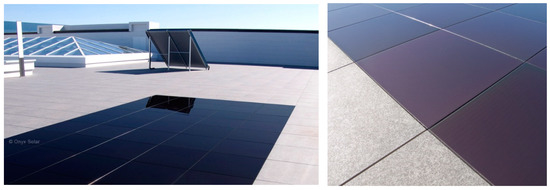
Figure 5.
Walkable photovoltaics solution for the flat roof (source: Onyx Solar).
Interestingly, the PVT prototype developed by Greppi et al. [113] for a new hybrid solar panel, as per Figure 6, can be used as a tile to pave driveways, areas, and terraces and to cover roofs due to its particular robustness and compactness. The main feature, that characterizes the new hybrid tile, is its walkability and the simple laying procedure.
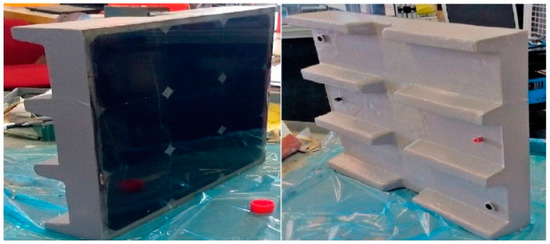
Figure 6.
Photovoltaic cells, heat sink enclosed in transparent and opaque resins with on left hydraulic and electrical connectors [113].
The problem of laying in historical buildings subject to difficult retrofitting must be fully assessed also with regards to the additional loads that are applied to the underlying structures and the technical bulky structures.
Organic solar technologies seem to be a very promising cell-based solution. The 6% efficiency is, of course, a big minus, however, through the continued development in technology and research, its efficiency is gradually increasing. One of the advantages of organic cells is that, when compared to CIGS cells (copper indium gallium selenide solar cell), organic cells don’t require rare elements such as Indium.
The lifespan of these solar modules is approximately 15 years. This technology is expected to be a bit less durable than glass modules, but a 15-year lifespan is not bad at all [114].
2.4. Energy Efficiency
The main objective of the research in the photovoltaic sector is to achieve a high solar energy conversion efficiencies using widely available raw materials, and sustainability both, from an economic and environmental point of view.
As reported in Table 6, the growth and development forecasts for the next few years of photovoltaic technologies are still very much linked to Silicon-based components.

Table 6.
Technology goals and key R and D issues for crystalline silicon technologies (Source: Technology Roadmap, solar photovoltaic energy, IEA 2010).
As already mentioned above, the main limitation of BIPV on the listed and THB is the visual impact; mainly the PV cell.
2.5. Colored Cells and Glazing Modules
One of the main problems in BIPV solutions on traditional materials are factors, related to module/cell color, pattern, texture, and visible materials [115].
The concept of a low impact solution for photovoltaic components on historical materials is based on preserving the history and value of the product, and the final result obtained. Reversibility to the original state is fundamental if the BIPV solutions are replaced or removed.
The first and most important element pointed out by market surveys was the need to change the color of the PV module from the blue-purple tones of standard technologies to a more terra-cotta like color matching traditional roofing materials [116].
The need to make photovoltaic components “invisible” on building envelopes is a very advanced research objective. The color of the external finish is one of the main obstacles of BIPV solutions.
Reflection losses limit all types of photovoltaic devices. The first reflection loss occurs at the glass-air interface of the photovoltaic module. If no light trapping mechanism is used, about 4% of the solar energy is lost on this surface [117]. The most commonly used techniques in reducing reflection, include texturing of the glass surface and the application of an anti-reflective coating (ARC). The simplest ARC consists of a single layer of refractive index matching material [118]. High quality anti-reflection (AR) coatings have become a vital feature of high-efficiency silicon solar cells. Solar cell efficiency can be improved by antireflection gratings. The silicon material has a high refractive index. Understanding how to develop broadband and omnidirectional antireflection is a key technology for increasing solar energy efficiency [119].
Most of these ARCs are manufactured by film deposition techniques such as chemical vapour deposition (CVD), sputtering, or evaporation, as well as possible lithography steps on perovskite solar cells [120].
Therefore, RCs are of great importance in improving the efficiency of the solar cell by reducing loss due to reflection. ARCs containing a single layer can be non-reflective only at a single wavelength, generally up to the middle of the visible spectrum. Whereas, ARCs containing double layers are effective over the entire visible spectrum [121].
The predominantly dark color of the photovoltaic cells is designed to reflect as little light as possible. This way the solar cell will produce the maximum power output. The color of the solar cells can be changed by varying the thickness of the anti-reflection coating. By reducing the thickness of the anti-reflection layer, the overall reflection will increase and the efficiency decrease by 15–30%, depending on the color.
Using antireflection coatings (ARCs) processes suitable for large-scale manufacturing, many authors have explored new materials and process modifications to systematically reduce conversion losses in devices manufactured on low-cost glass substrates [122].
More precisely, colored modules with high saturation, angle independent color appearance, and a minimized color, induced targeted efficiency loss. Homogeneous colored layers have a high transmittance in wavelength range with non-negligible spectral responsivity of the PV-cells [123].
BIPV latest generation solutions allow access to solutions with high integration and low visual impact even on historical buildings enclosures.
The technological solutions in the field of colored and transparent solar technologies represent one of the most promising for application on historical buildings. The colored solutions, including different crystalline Si cells and Thin-film technologies have been available on the market for several years.
The coloring of the active PV component and a specific design process offer opportunities and innovative BIPV solutions that can also be implemented on valuable enclosures.
There are two very promising and innovative solutions for heritage building envelopes: transparent solar technologies and selective materials, with low molecular density solar radiation that reproduce the components and colors of traditional material.
Further advances have been made in applied research on the color of materials used in the production of photovoltaic cells. Market projections predict that in 2020 the price of these modules will decrease by 20% concerning 2013.
The adoption of innovative technologies for colored photovoltaic cells with a high energy yield will make it possible to correct, or at least mitigate, the historical conflict of technological systems versus safeguarding and preserving the historical and architectural heritage.
2.6. Glazing
The glazing application on a THB envelope represents one of the more interesting opportunities in energy retrofitting solutions. The minimum glazing available surface on a building is approximately 30%. The potential of these solutions on historical buildings from an nZEB perspective offers a vast scope of very interesting opportunities in future years when the current more promising solutions will have acceptable EPBT. Window-integrated Photovoltaic (WIPVs) is a system that generates electrical energy from glass and windows [124].
2.7. Light Selective Compound for Traditional Materials (multilayering)
Any alternative energy technology that is supposed to address the problem of energy sufficiency and security and climate change must be: Simple, easily scalable and inexpensive.
This results from the controlled and coherent integration of the solar collectors simultaneously from all functional, constructive, and formal (aesthetic) points of view [115].
These so-called “invisible” solutions are available on the market [23]. The silicon cells are completely embedded in the body of the same as these are made of polymeric compounds loaded with natural powders. The result is that they are similar in appearance to traditional materials, and at the same time, allow sunlight to filter through the outer surface (as if it were transparent) and reach the photovoltaic cells.
The principle is stratification (layering) achieved by superimposing low molecular density polymeric materials over the PV cell [35]. In this case, the layering technique does not concern the cell but the external finish, with particular optical properties that allow camouflaging the tile on the components of the building envelope.
The single roof coppo-tile, as per Figure 7, has a power of 4.5 Wp. To obtain a power of 1 kWp, 223 roof tiles are necessary for a surface of 15 m2. Technological innovations prove that multifunction optics open up very interesting solutions. It is possible to propose low impact BIPV solutions, not only on roofs, but also on architectural technological units and historical, as well as traditional building materials.
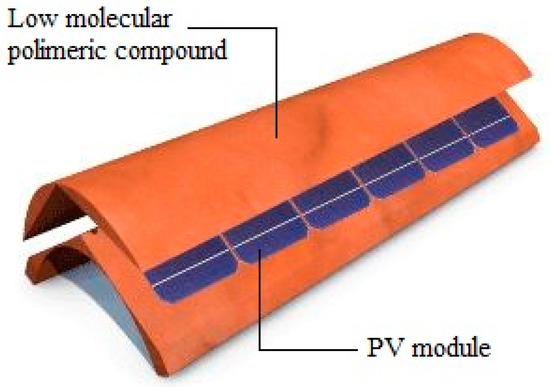
Figure 7.
PV coppo with a polymeric compound developed to encourage the photon absorption (source [35]).
A reference model of BIPV solutions is proposed as functional for technologies, visual impact, the level of integration per architectural unit and potential integration on traditional materials.
Solutions that can have win-win a result on the extended historical buildings stock not subject to restrictions and in non-prestigious urban areas. Such an extension of active solar surfaces contributes to an increase in the production of electricity from a primary source for each building beyond certain protection constraints. Some architectural elements of historical buildings, such as cornices, terraces, vertical walls and traditional roofs in Roman tile, are presented in this paper for their photovoltaic solarization.
3. Results
The availability of BIPV multifunctional components opens up the possibility of low-visual impact energy retrofit interventions on the heritage buildings stock.
The limits of integration are not of a technological or aesthetic nature to respect the historical value of the enclosures. Given the current levels of integration achieved, in the present work, an analysis was carried out comparing BAPV and BIPV approaches for heritage buildings to highlight opportunities and constraints. This analysis provides an effective means of ‘mapping’ the current situation and identifying chances for future developments.
In the present work, practical involvement is explored not only from a holistic point of view but also to examine the relationship between supportability and conservation in the field of the energy efficiency applied to the historical building property as per Figure 8.
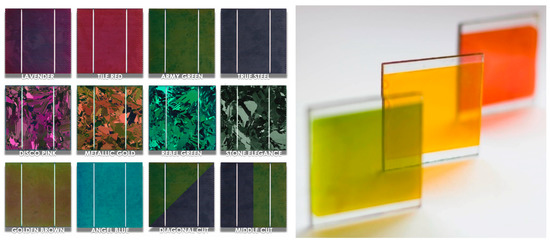
Figure 8.
(Source: www.lofsolar.com) and Perovskite transparent PV cell.
The solutions supplied by BAPV to BIPV on historical buildings need an innovative methodological approach that involves guardianship organs, seekers and planners for a reverse photovoltaic design. In this work, we propose the Heritage Building Energy Solar Solution Technologies (hBESST) as a synthesis approach to meet the needs of the energy retrofit, the protection and preservation of the historical building stock and the BIPV solutions.
A solution to the integration of integrated solar technologies on a historical building is proposed in Table 7 through various levels; from a high-impact BAPV to a low-impact BHESST concerning the opportunities and constraints exposed above.

Table 7.
Approaches and criteria within the Heritage Building Management Process for different BIPV solutions.
The holistic approach frames define and quantify the opportunities and constraints that emerged using a simple 3-value scale of Low (*), medium (**) and High (***). Subsequently, to provide typical indications of the building process, through BIPV design solutions and practical implementation, it was possible to define an initial example on how to intervene on typical architectural elements of THBs already available on the market.
The methodology of the building process for heritage buildings in the field of energy retrofit shows clear limits of replicability given the specificity of each case on which to intervene. However, this does not mean that we can generalize the process with the detriment of the principles of protection and safeguarding, by identifying three objectives: BIPV, Heritage Buildings (Hbuil) and nZEB.
Within the hBESST process, three BIPV, nZEB and hBuil targets were defined and four interactions were identified, as shown in Figure 9.
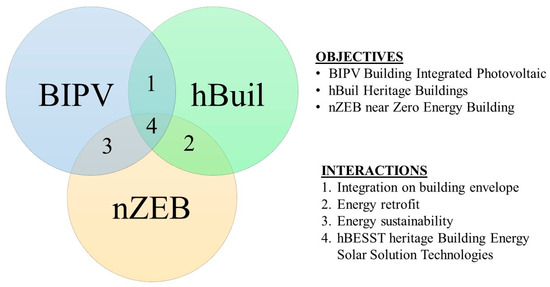
Figure 9.
Four interactions between three objectives to obtain the heritage building management system hBESST.
Point 4 represents the maximum number of integration conditions required to establish a structured process that goes from the needs of energy sustainability up to the development phase on the scale of the single architectural element on historical buildings, including THB.
For each interaction, through a holistic approach, the hBESST has made it possible to highlight 23 factors that can be assessed according to opportunities and constraints as reported in Table 8.

Table 8.
Opportunities and constraints assessment according to the factors determined by the interactions.
The following table provides comparative solutions for laying surfaces by evaluating BIPV and hBESST solutions.
The technologies are presented based on PV technology, the efficiency of electricity production and annual producibility per 1 m2 installed.
Table 9 shows how some hBESST solutions on building envelope components on historical buildings can be developed with technologies already available on the market. For the glazing and WIPV solutions, market solutions with acceptable EROI and EPBT are not yet available. In 2030, the solarization of glazed surfaces is expected to reach levels of economic acceptability.

Table 9.
Comparison between traditional BIPV and BHESST solutions on historical building envelopes and technological and visual impact parameters.
A bottom-up approach was adopted which, starting from the level of integration on the historical building component, has allowed formulating interactions and factors related to energy retrofit on the enclosures of historical buildings [86].
Figure 10 shows the bottom-up approach concerning the hBESST and hBMP objectives.
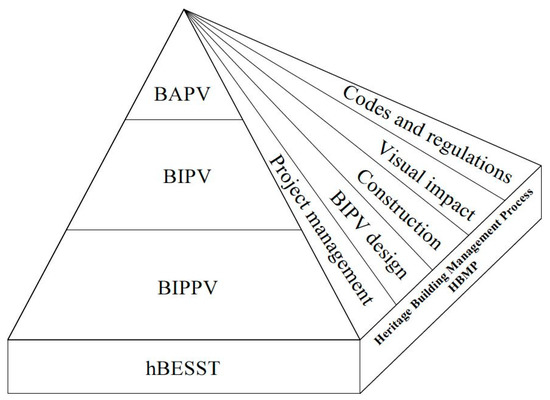
Figure 10.
Bottom-up approach schematization of the hBESST procedure.
Related adoptions have been assessed and incorporated in this work.
Table 10 shows the main opportunities and constraints of hBESST regarding know-how, training and economic barriers, and to a lesser extent, technological barriers. The need to carry out case studies with innovative and low impact solutions starting from the unconstrained historical building stock can also accelerate overcoming barriers linked to codes and conservation rules.

Table 10.
Compare BIPV and hBESST and related opportunities and constraints.
The process outlined in this paper can be implemented on that part of a historical building stock, such as THB in urban contexts, without constraints and architectural and landscape protection. An hBESST approach allows you to tackle solutions with a low visual impact on traditional materials and surfaces.
Heritage BIM solutions and applications for energy retrofitting, and in particular for BIPV solutions, represent a huge potential for numerous researches. HBIM applied to the specificity of THB defines a new relationship between BIPV, traditional materials and optimization of a workflow, where BIPV, nZEB and the Heritage/Historical buildings represent an opportunity and not a constraint.
The BIM informative process is classified in seven levels of which the first three are linked to the geometry of the objects while 4D is applied to scheduling, 5D is applied to estimation, 6D is applied to sustainability and 7D is applied to facility management applications. The energy component turns out to be transversal for all seven levels but determining for levels from 4D to 7D.
The BIM and HBIM solutions in a multilevel and interoperable digitization process represent obligatory paths as they allow for the analysis and evaluation of hBESST choices, thereby facilitating the choice at all levels of design for BIPV solutions.
The constraints concern the LOD definition, the parametric digitization of all the BIPV components within the typical workflow of the BIM processes.
This first phase of the research will be integrated later in the second phase with an evaluation procedure on the components of BIPV on historical buildings through votes and opinions formulated by experts in the field.
4. Discussion
The process outlined in this paper can be implemented on that part of a historical building stock, such as THB in urban contexts, without constraints, architectural and landscape protection. An hBESST approach allows you to tackle solutions with a low visual impact on traditional materials and surfaces.
Heritage BIM solutions and applications for energy retrofitting, and in particular for BIPV solutions, represent a huge potential for numerous researches. HBIM, applied to the specificity of THB, defines a new relationship between BIPV, traditional materials and optimization of a workflow where BIPV, nZEB and the Heritage/Historical buildings represent an opportunity and not a constraint.
The BIM informative process is classified in seven levels of which the first three are linked to the geometry of the objects while 4D is applied to scheduling, 5D is applied to estimation, 6D is applied to sustainability and 7D is applied to facility management applications. The energy component turns out to be transversal for all seven levels but determining for levels from 4D to 7D.
The BIM and HBIM solutions in a multilevel and interoperable digitization process represent obligatory paths as they allow for the analysis and evaluation of hBESST choices, thereby facilitating the choice at all levels of design for BIPV solutions.
The constraints concern the LOD definition, the parametric digitization of all the BIPV components within the typical workflow of the BIM processes.
This first phase of the research will be integrated later in the second phase with an evaluation procedure on the components of BIPV on historical buildings through votes and opinions formulated by experts in the field.
5. Conclusions
The present work aims to investigate the opportunities and to outline the limits and the opportunities that BIPV design approaches offer during architectural and energetic upgrading interventions on historical buildings. The interactions of the three main objectives, BIPV, Hbuil and nZEB, have been analyzed using traditional Heritage Building Solar Solutions Technologies (hBESST). Subsequently, through a bottom-up process for individual materials and PV technologies on enclosures of historical buildings, we defined a Heritage Building Energy Solar Solution Technologies (hBESST) as the first approach of synthesis to the needs of the energy retrofit, BIPV solutions, and protection and preservation of the historical building stock.
The challenge in hBESST design is to find the best combination of design strategies that will face the energy performance problems of a THB and future listed buildings.
The PV’s maximization producibility on a historical building property cannot be the only methodological reference. The technical solutions are shown in the present paper. An hBESST approach can be defined if, for example, cornice solarization and roof floors are opportunely inserted into project integration management. Integration interventions on other traditional materials can be designed to keep the natural balance and protect the landscape, the historical patrimony and the energetic sustainability. The latest generation PV components, colored and highly invisible, open very interesting design perspectives.
The results highlighted have been submitted to give indications and cues in evaluating the limits that RES solutions, and in this case BIPV, can present on the historical building stock.
Funding
This research received no external funding
Conflicts of Interest
The authors declare no conflict of interest.
References
- European Commission. Communication From the Commision: A Roadmap for Moving to a Competitive Low Carbon Economy in 2050; COM(2011) 112 Final 34; European Commission: Brussels, Belgium, 2011; pp. 1–34. [Google Scholar] [CrossRef]
- D’Agostino, D.; Mazzarella, L. What is a Nearly zero energy building? Overview, implementation and comparison of definitions. J. Build. Eng. 2019, 21, 200–212. [Google Scholar] [CrossRef]
- Kurnitski, J.; Allard, F.; Al, E. How to Define Nearly Net Zero Energy Buildings nZEB—REHVA Proposal for Uniformed National Implementation of EPBD Recast. Available online: https://www.rehva.eu/fileadmin/hvac-dictio/03-2011/How_to_define_nearly_net_zero_energy_buildings_nZEB.pdf (accessed on 9 May 2018).
- Hermelink, A.; Schimschar, S.; Boer, T. Towards Nearly Zero-Energy Buildings Definition of Common Principles under the EPBD Final Report, Köln. 2012. Available online: https://ec.europa.eu/energy/sites/ener/files/documents/nzeb_full_report.pdf (accessed on 11 May 2018).
- Romagnoni, P. Edifici a Basso Consumo Energetico: Tra ZEB e NZEB, Ppt. Available online: https://sistemaedificio.files.wordpress.com/2015/03/romagnoni_venezia.pdf (accessed on 8 May 2018).
- Deng, S.; Wang, R.Z.; Dai, Y.J. How to evaluate performance of net zero energy building—A literature research. Energy 2014, 71, 1–16. [Google Scholar] [CrossRef]
- Mauri, L. Feasibility Analysis of Retrofit Strategies for the Achievement of NZEB Target on a Historic Building for Tertiary Use. Energy Procedia 2016, 101, 1127–1134. [Google Scholar] [CrossRef]
- International Energy Agency (IEA). Technology Roadmap Solar Photovoltaic Energy—2014 Edition; Technology Roadmap; IEA: Paris, France, 2014. [Google Scholar] [CrossRef]
- SET-Plan—Declaration on Strategic Targets in the context of an Initiative for Global Leadership in Photovoltaics (PV); European Commission: Brussels, Belgium, 2016.
- Aste, N.; Adhikari, R.S.; Del Pero, C. Photovoltaic Technology for Renewable Electricity Production: Towards Net Zero Energy Buildings. In Proceedings of the 2011 International Conference on Clean Electrical Power (ICCEP), Ischia, Italy, 14–16 June 2011; pp. 446–450. [Google Scholar] [CrossRef]
- Ferrara, C.; Wilson, H.R.; Sprenger, W. Building-integrated photovoltaics (BIPV). In The Performance of Photovoltaic (PV) Systems: Modelling, Measurement and Assessment; Elsevier Inc.: Freiburg, Germany, 2017; pp. 235–250. [Google Scholar] [CrossRef]
- SET-Plan TWP PV Implementation PlanFinal Draft. 2017. Available online: https://setis.ec.europa.eu/system/files/set_plan_pv_implmentation_plan.pdf (accessed on 15 January 2020).
- MIBACT Ministero per i Beni e le Attività Culturali, Legislative Decree n. 42 of 22 January 2004. Code of Cultural and Landscape Heritage. 2004. Available online: http://www.unesco.org/culture/natlaws/media/pdf/italy/it_cult_landscapeheritge2004_engtof.pdf (accessed on 23 March 2017).
- Rosa, F.; Carbonara, E. An analysis on technological plant retrofitting on the masonry behaviour structures of 19th century Traditional Historical Buildings (THB) in Rome. Energy Procedia 2017, 133, 121–134. [Google Scholar] [CrossRef]
- European Union (EU). Directive 2010/31/EU of the European Parliament and of the Council of 19 May 2010 on the Energy Performance of Buildings; EU: Brussels, Belgium, 2010. [Google Scholar] [CrossRef]
- EU. DIRECTIVE (EU) 2018/844 of the European Parliament and of the Council of 30 May 2018 Amending Directive 2010/31/EU on the Energy Performance of Buildings and Directive 2012/27/EU on Energy Efficiency (Text with EEA Relevance); EU: Brussels, Belgium, 2018. [Google Scholar]
- Decree of June 26th, 2015 Concerning New Minimum Requirements and Methodology for Calculating Energy Performance of Buildings. 2015. Available online: https://www.mise.gov.it/index.php/it/normativa/decreti-interministeriali/2032966-decreto-interministeriale-26-giugno-2015-applicazione-delle-metodologie-di-calcolo-delle-prestazioni-energetiche-e-definizione-delle-prescrizioni-e-dei-requisiti-minimi-degli-edifici (accessed on 9 January 2020).
- De Santoli, L. Guidelines on energy efficiency of cultural heritage. Energy Build. 2015, 86, 534–540. [Google Scholar] [CrossRef]
- Nastasi, B.; di Matteo, U. Solar Energy Technologies in Sustainable Energy Action Plans of Italian Big Cities. Energy Procedia 2016, 101, 1064–1071. [Google Scholar] [CrossRef]
- Feilden, B.M. Conservation of Historic Buildings; Architectural Press: New York, NY, USA, 2003; Available online: http://www.hoepli.it/libro/conservation-of-historic-buildings/9780750658638.html (accessed on 24 March 2017).
- Guidance on Heritage Impact Assessments for Cultural World Heritage Properties, 2011, ICOMOS. Available online: https://www.icomos.org/world_heritage/HIA_20110201.pdf (accessed on 10 July 2020).
- Mancini, F.; Nastasi, B. Energy retrofitting effects on the energy flexibility of dwellings. Energies 2019, 12, 2788. [Google Scholar] [CrossRef]
- MiBACT. Linee di Indirizzo per il Miglioramento Dell’efficienza Energetica nel Patrimonio Culturale. Architettura, Centri e Nuclei Storici ed Urbani; MiBACT: Rome, Italy, 2014. [Google Scholar]
- WP2: Standardisation and Testing | Construct PV. Available online: http://www.constructpv.eu/wp2-standardisation-and-testing/ (accessed on 15 May 2018).
- Italian Company for Standardization. UNI 8290-1:1981+A122:1983: Residential Building. Building Elements. Classification and Terminology; Italian Company for Standardization: Milan, Italy, 1983. [Google Scholar]
- Pagliaro, M.; Ciriminna, R.; Palmisano, G. BIPV: Merging the photovoltaic with the construction industry. Prog. Photovolt. Res. Appl. 2010, 18, 61–72. [Google Scholar] [CrossRef]
- Heinstein, P.; Ballif, C.; Perret-Aebi, L.-E.E. Building integrated photovoltaics (BIPV): Review, potentials, barriers and myths. Green 2013, 3, 125–156. [Google Scholar] [CrossRef]
- Delponte, E.; Marchi, F.; Frontini, F.; Polo, C.; Fath, K.; Batey, M. BIPV in eu28, from niche to mass market: An assessment of current projects and the potential for growth through product innovation. In Proceedings of the 31st European Photovoltaic Solar. Energy Conference and. Exhibition (EU PVSEC 2015), Hamburg, Germany, 14–18 September 2015; pp. 3046–3050. [Google Scholar]
- Defaix, P.R.; van Sark, W.G.J.H.M.; Worrell, E.; de Visser, E. Technical potential for photovoltaics on buildings in the EU-27. Sol. Energy 2012, 86, 2644–2653. Available online: http://linkinghub.elsevier.com/retrieve/pii/S0038092X12002186 (accessed on 14 May 2018). [CrossRef]
- El Gammal, A.; Mueller, D.; Buerkstuemmer, H.; Vignal, R.; Macé, P. Technical Evaluation of BIPV Power Generation Potential in EU-28. 2016, pp. 2518–2522. Available online: http://becquerelinstitute.org/wp-content/uploads/2014/08/6DO-8-final-BIPV-Technical-Potential.pdf (accessed on 14 May 2018).
- Osseweijer, F.J.W.; van den Hurk, L.B.P.; Teunissen, E.J.H.M.; van Sark, W.G.J.H.M. A Review of the Dutch Ecosystem for Building Integrated Photovoltaics. Energy Procedia 2017, 111, 974–981. [Google Scholar] [CrossRef]
- Mancini, F.; Nastasi, B. Solar energy data analytics: PV deployment and land use. Energies 2020, 13, 417. [Google Scholar] [CrossRef]
- Godwin, P.J. Building Conservation and Sustainability in the United Kingdom. Procedia Eng. 2011, 20, 12–21. [Google Scholar] [CrossRef]
- Selj, J.H.; Mongstad, T.T.; Søndenå, R.; Marstein, E.S. Reduction of optical losses in colored solar cells with multilayer antireflection coatings. Sol. Energy Mater. Sol. Cells 2011, 95, 2576–2582. [Google Scholar] [CrossRef]
- Invisible Solar | Dyaqua. Available online: http://www.dyaqua.it/invisiblesolar/_it/index.php (accessed on 19 May 2018).
- Escarre, J.; Li, H.-Y.Y.; Sansonnens, L.; Galliano, F.; Cattaneo, G.; Heinstein, P.; Nicolay, S.; Bailat, J.; Eberhard, S.; Ballif, C.; et al. When PV modules are becoming real building elements: White solar module, a revolution for BIPV. In Proceedings of the 2015 IEEE 42nd Photovoltaic Specialist Conference (PVSC), New Orleans, LA, USA, 14–19 June 2015; pp. 1–2. [Google Scholar] [CrossRef]
- Swissinso–Kromatix. Available online: http://www.swissinso.com/company/technology.html (accessed on 17 March 2017).
- Kuo, H.J.; Hsieh, S.H.; Guo, R.C.; Chan, C.C. A verification study for energy analysis of BIPV buildings with BIM. Energy Build. 2016, 130, 676–691. [Google Scholar] [CrossRef]
- Jakica, N. State-of-the-art review of solar design tools and methods for assessing daylighting and solar potential for building-integrated photovoltaics. Renew. Sustain. Energy Rev. 2018, 81, 1296–1328. [Google Scholar] [CrossRef]
- Piselli, C.; Romanelli, J.; di Grazia, M.; Gavagni, A.; Moretti, E.; Nicolini, A.; Cotana, F.; Strangis, F.; Witte, H.J.L.; Pisello, A.L. An integrated HBIM simulation approach for energy retrofit of historical buildings implemented in a case study of a medieval fortress in Italy. Energies 2020, 13, 2601. [Google Scholar] [CrossRef]
- Magrini, A.; Franco, G.; Guerrini, M. The Impact of the Energy Performance Improvement of Historic Buildings on the Environmental Sustainability. Energy Procedia 2015, 75, 1399–1405. [Google Scholar] [CrossRef]
- Xu, R.; Wittkopf, S.; Roeske, C. Quantitative Evaluation of BIPV Visual Impact in Building Retrofits Using Saliency Models. Energies 2017, 10, 668. [Google Scholar] [CrossRef]
- van Berkel, B.; Minderhoud, T.; Piber, A.; Gijzen, G. Design innovation from PV_module to building envelope (EU PVSEC 2014). In Proceedings of the 29th European Photovoltaic Solar Energy Conference and Exhibition, Amsterdam, The Netherlands, 22–26 September 2014; pp. 3606–3612. [Google Scholar]
- MacLeod, H.A. Thin Film Optical Filters. 2001. Available online: https://kashanu.ac.ir/Files/thin%20film%20optical%20filter(macklod).pdf (accessed on 22 May 2020).
- Stauffer, N.W.M. Solar photovoltaic technologies: Silicon and beyond. Energy Future 2015, 8–12. Available online: http://energy.mit.edu/news/transparent-solar-cells/ (accessed on 20 December 2019).
- Lim, J.W.; Kim, G.; Shin, M.; Yun, S.J. Colored a-Si:H transparent solar cells employing ultrathin transparent multi-layered electrodes. Sol. Energy Mater. Sol. Cells 2017, 163, 164–169. [Google Scholar] [CrossRef]
- Decree, I. Decreto Interministeriale n.1444. Available online: https://www.gazzettaufficiale.it/eli/id/1968/04/16/1288Q004/sg (accessed on 3 February 2020).
- Clarke, J.A.; Hand, J.W.; Johnstone, C.M.; Kelly, N.; Strachan, P.A. Photovoltaic-integrated building facades. Renew. Energy 1996, 8, 475–479. [Google Scholar] [CrossRef]
- Yang, T.; Athienitis, A.K. A review of research and developments of building-integrated photovoltaic/thermal (BIPV/T) systems. Renew. Sustain. Energy Rev. 2016, 66, 886–912. [Google Scholar] [CrossRef]
- Recchia, A.P. Problematiche e Opportunità Nell’uso Delle Fonti Energetiche Rinnovabili nel Patrimonio Storico Monumentale, MIBACT Ministero per i Beni e le Attività Culturali, Milan. 2011. Available online: http://www.iborghisrl.it/new/wp-content/uploads/2011/10/Convegno-Milano-5-ottobre-2011.pdf (accessed on 21 February 2017).
- Frontini, F.; Scognamiglio, A.; Graditi, G.; Lopez, C.P.; Pellegrino, M. From BIPV to Building Component. Available online: http://www.constructpv.eu/wp-content/uploads/2015/06/PVSEC_FF_1.pdf (accessed on 15 May 2018).
- Pacheco-torgal, F.; Granqvist, C.G.; Jelle, B.P.; Vanoli, G.P. Cost-Effective Energy Efficient Building Retrofitting: Materials, Technologies, Optimization and Case Studies; Woodhead Publishing: Duxford, UK.
- López, C.S.P.; Frontini, F. Energy Efficiency and Renewable Solar Energy Integration in Heritage Historic Buildings. Energy Procedia 2014, 48, 1493–1502. [Google Scholar] [CrossRef]
- Pellegrino, M.; López, C.P.; Graditi, G.; Scognamiglio, A.; Frontini, F. From BIPV to Building Component. In Proceedings of the 28th European Photovoltaic Solar Energy Conference and Exhibition, Paris, France, 30 September–4 October 2013; pp. 3757–3761. [Google Scholar] [CrossRef]
- Materials and Devices | Photovoltaic Research | NREL. Available online: https://www.nrel.gov/pv/materials-devices.html (accessed on 24 May 2018).
- IEA PVPS Trend 2017 in Photovoltaics Applications. 2017. Available online: http://iea-pvps.org/fileadmin/dam/public/report/statistics/IEA-PVPS_Trends_2017_in_Photovoltaic_Applications.pdf (accessed on 22 February 2020).
- Green, M.A.; Emery, K.; Hishikawa, Y.; Warta, W.; Dunlop, E.D. Solar cell efficiency tables (version 45). Prog. Photovolt. Res. Appl. 2015, 23, 1–9. [Google Scholar] [CrossRef]
- Cerón, I.; Caamaño-Martín, E.; Neila, F.J. ‘State-of-the-art’ of building integrated photovoltaic products. Renew. Energy 2013, 58, 127–133. [Google Scholar] [CrossRef]
- Green, M.A.; Hishikawa, Y.; Dunlop, E.D.; Levi, D.H.; Hohl-Ebinger, J.; Ho-Baillie, A.W.Y. Solar cell efficiency tables (version 51). Prog. Photovolt. Res. Appl. 2017, 26, 3–12. [Google Scholar] [CrossRef]
- Nastasi, B.; Basso, G.L. Hydrogen to link heat and electricity in the transition towards future Smart Energy Systems. Energy 2016, 110, 5–22. [Google Scholar] [CrossRef]
- de Santoli, L.; Basso, G.L.; Nastasi, B. The Potential of Hydrogen Enriched Natural Gas deriving from Power-to-Gas option in Building Energy Retrofitting. Energy Build. 2017, 149, 424–436. [Google Scholar] [CrossRef]
- Carbonara, G. Energy efficiency as a protection tool. Energy Build. 2015, 95, 9–12. [Google Scholar] [CrossRef]
- Albo, A.; Rosa, F.; Tiberi, M.; Vivio, B. High-efficiency and low-environmental impact systems on a historical building in Rome: An InWall solution. WIT Trans. Built Environ. 2014, 142, 529–540. [Google Scholar] [CrossRef]
- Rosa, F.; Cumo, F.; Calcagnini, L.; Vivio, B. Redevelopment of Historic Buildings through the Implementation of Green Roofs: A Study of a Design Methodology. Available online: http://www.academia.edu/2421781/Redevelopment_of_historic_buildings_through_the_implementation_of_green_roofs_a_study_of_a_design_methodology (accessed on 9 September 2013).
- Jordan-Palomar, I.; Tzortzopoulos, P.; García-Valldecabres, J.; Pellicer, E. Protocol to Manage Heritage-Building Interventions Using Heritage Building Information Modelling (HBIM). Sustainability 2018, 10, 908. [Google Scholar] [CrossRef]
- Mazzola, E.; Mora, T.D.; Peron, F.; Romagnoni, P. An Integrated Energy and Environmental Audit Process for Historic Buildings. Energies 2019, 12, 3940. [Google Scholar] [CrossRef]
- Bruno, S.; De Fino, M.; Fatiguso, F. Historic Building Information Modelling: Performance assessment for diagnosis-aided information modelling and management. Autom. Constr. 2018, 86, 256–276. Available online: https://www.sciencedirect.com/science/article/pii/S0926580517301164?via%3Dihub (accessed on 27 March 2018). [CrossRef]
- Osello, A.; Rapetti, N.; Semeraro, F. BIM Methodology Approach to Infrastructure Design: Case Study of Paniga Tunnel. IOP Conf. Ser. Mater. Sci. Eng. 2017, 245, 62052. [Google Scholar] [CrossRef]
- Standardization Needs for BIPV. 2016. Available online: http://www.pvsites.eu/downloads/download/report-standardization-needs-for-bipv (accessed on 28 January 2020).
- BIPV Standards. Available online: http://www.bipv.ch/index.php/en/technology-top-en/quality/standards (accessed on 22 May 2018).
- Pellegrino, M.; Flaminio, G.; Graditi, G. Testing and Standards for new BIPV products. In Proceedings of the IECON 2013—39th Annual Conference of the IEEE Industrial Electronics Society, Vienna, Austria, 10–13 November 2013; pp. 8127–8132. [Google Scholar] [CrossRef]
- GSE—Building-Integrated PV (BIPV) Plants with Innovative Features. Available online: http://www.gse.it/en/feedintariff/Photovoltaic/Fourthfeed-intariff/PVintegratedwithinnovativecharacteristics/Pages/default.aspx (accessed on 17 February 2017).
- PVPS Annual Report 2017: Photovoltaic Power Systems Technology Collaboration Programme; IEA: Fribourg, Switzerland, 2017.
- Almosni, S.; Delamarre, A.; Jehl, Z.; Suchet, D.; Cojocaru, L.; Giteau, M.; Behaghel, B.; Julian, A.; Ibrahim, C.; Tatry, L.; et al. Material challenges for solar cells in the twenty-first century: Directions in emerging technologies. Sci. Technol. Adv. Mater. 2018, 19, 336–369. [Google Scholar] [CrossRef] [PubMed]
- Building Integrated Photovoltaics (BIPV) | WBDG Whole Building Design Guide. Available online: https://www.wbdg.org/resources/building-integrated-photovoltaics-bipv (accessed on 21 May 2018).
- Vikram, K. Fourth Generation Photovoltaics Research in India. 2016, p. 101. Available online: http://www.mineco.gob.es/stfls/MICINN/Investigacion/FICHEROS/Presentacion_participantes_Sevilla/06_Organic_Photovoltaics_RD_India_V_Kumar.pdf (accessed on 23 November 2019).
- Kukreti, K.; Rathod, A.P.S.; Kumar, B. Recent Advancements and Overview of Organic Solar Cell; Institute of Electrical and Electronics Engineers Inc.: Piscataway, NJ, USA, 2017; pp. 1539–1544. [Google Scholar] [CrossRef]
- Berny, S.; Blouin, N.; Distler, A.; Egelhaaf, H.-J.; Krompiec, M.; Lohr, A.; Lozman, O.R.; Morse, G.E.; Nanson, L.; Pron, A.; et al. Solar Trees: First Large-Scale Demonstration of Fully Solution Coated, Semitransparent, Flexible Organic Photovoltaic Modules. Adv. Sci. 2015, 3, 1500342. [Google Scholar] [CrossRef]
- Anderson, A.-L.; Chen, S.; Romero, L.; Top, I.; Binions, R. Thin Films for Advanced Glazing Applications. Buildings 2016, 6, 37. [Google Scholar] [CrossRef]
- Ferrari, S.; Romeo, C. Retrofitting under protection constraints according to the nearly Zero Energy Building (nZEB) target: The case of an Italian cultural heritage’s school building. Energy Procedia 2017, 140, 495–505. [Google Scholar] [CrossRef]
- Ascione, F.; de Masi, R.F.; de Rossi, F.; Ruggiero, S.; Vanoli, G.P. NZEB target for existing buildings: Case study of historical educational building in Mediterranean climate. Energy Procedia 2017, 140, 194–206. [Google Scholar] [CrossRef]
- Poggi, F.; Firmino, A.M.V.; Amado, M.P.; Pinho, F.F.S. Natural stone walls in vernacular architecture: What contribution towards rural nZEB concept? Bulletin de La Société Géographique de Liège 2015, 65, 51–66. [Google Scholar]
- Sala, M.; López, C.S.P.; Frontini, F.; Tagliabue, L.C.; de Angelis, E. The Energy Performance Evaluation of Buildings in an Evolving Built Environment: An Operative Methodology. Energy Procedia 2016, 91, 1005–1011. [Google Scholar] [CrossRef][Green Version]
- Sartori, I.; Napolitano, A.; Voss, K. Net zero energy buildings: A consistent definition framework. Energy Build. 2012, 48, 220–232. Available online: https://ac.els-cdn.com/S0378778812000497/1-s2.0-S0378778812000497-main.pdf?_tid=4411dcf4-d5f7-46a8-b232-310af439279b&acdnat=1524817651_ae3ea6d3b3e462f45c299317e1ece6f0 (accessed on 27 April 2018). [CrossRef]
- Klein, K.; Kalz, D.; Herkel, S. Grid impact of a net zero energy building with BiPV using different energy management strategies. In Proceedings of the International Conference CISBAT 2015 Future Buildings and Districts Sustainability from Nano to Urban Scale, Lausanne, Switzerland, 9–11 September 2015; pp. 579–584. [Google Scholar] [CrossRef]
- Mancini, F.; Cecconi, M.; de Sanctis, F.; Beltotto, A. Energy Retrofit of a Historic Building Using Simplified Dynamic Energy Modeling. Energy Procedia 2016, 101, 1119–1126. [Google Scholar] [CrossRef]
- Garcia, D.A.; Cumo, F.; Tiberi, M.; Sforzini, V.; Piras, G. Cost-Benefit Analysis for Energy Management in Public Buildings: Four Italian Case Studies. Energies 2016, 9, 522. [Google Scholar] [CrossRef]
- Ritzen, M.; Reijenga, T.; El Gammal, A.; Warneryd, M.; Sprenger, W.; Rose-Wilson, H.; Payet, J.; Morreau, V.; Boddaert, S. IEA-PVPS Task 15. In Proceedings of the 48th IEA PVPS Executive Commitee Meeting, Vienna, Austria, 15–16 November 2016. [Google Scholar]
- Transparency Market Research, BIPV Market Report. Available online: http://www.dem4bipv.eu/bipv/bipv-market/ (accessed on 20 February 2017).
- General Motors Research. Building Integrated Photovoltaics: An Emerging Market. Available online: https://www.solarserver.com/solar-magazine/solar-report/solar-report/building-integrated-photovoltaics-an-emerging-market.html (accessed on 17 May 2018).
- Horizon Prize for Integrated Photovoltaic System in European Protected Historic Urban Districts. Available online: https://ec.europa.eu/research/participants/portal/desktop/en/opportunities/h2020/topics/lce-prize-photovoltaicshistory-01-2016.html (accessed on 19 May 2018).
- Adamson, K.-A. Philip Drachman Industry Analyst Executive Summary: Building Integrated Photovoltaics Section 1. 2012. Available online: http://webcache.googleusercontent.com/search?q=cache:ZVsjTWMFpxIJ:www.sustainworldwide.com/uploads/5/0/6/1/5061561/bipv-10-executive-summary.pdf+&cd=1&hl=zh-TW&ct=clnk (accessed on 10 July 2020).
- Ritzen, M.; Reijenga, T.; El Gammal, A.; Warneryd, M.; Sprenger, W.; Rose-Wilson, H.; Payet, J. Enabling Framework for BIPV Acceleration. Available online: https://webcache.googleusercontent.com/search?q=cache:96NKZsUZDxgJ:https://www.photovoltaic-conference.com/images/2016/2_Programme/parallel_events/AccelerationBIPV/Michiel_RITZEN.pdf+&cd=1&hl=zh-TW&ct=clnk&gl=us (accessed on 10 July 2020).
- James, T.; Goodrich, A.; Woodhouse, M.; Margolis, R.; Ong, S. Building-Integrated Photovoltaics (BIPV) in the Residential Sector: An Analysis of Installed Rooftop System Prices; U.S. Department of Energy: Washington, DC, USA, 2011; p. 50. [Google Scholar]
- IRENA. The Power to Change: Solar and Wind Cost Reduction Potential; IRENA: Abu Dhabi, UAE, 2016. [Google Scholar]
- Fthenakis, V. PV Energy ROI. Track Efficiency Gains. Solar Today. 2012; p. 3. Available online: https://www.bnl.gov/pv/files/pdf/240_SolarTodayJune12_c.pdf (accessed on 20 December 2019).
- Raugei, M.; Sgouridis, S.; Murphy, D.; Fthenakis, V.; Frischknecht, R.; Breyer, C.; Bardi, U.; Barnhart, C.; Buckley, A.; Carbajales-Dale, M.; et al. Energy Return on Energy Invested (ERoEI) for photovoltaic solar systems in regions of moderate insolation: A comprehensive response. Energy Policy 2017, 102, 377–384. [Google Scholar] [CrossRef]
- Deriche, M.A.; Hafaifab, A.; Mohammedia, K. EPBT and CO2 emission from solar PV monocrystaline silicon. In Proceedings of the 2018 International Conference on Applied Smart Systems (ICASS), Medea, Algeria, 24–25 November 2018. [Google Scholar] [CrossRef]
- Bhandari, K.P.; Collier, J.M.; Ellingson, R.J.; Apul, D.S. Energy payback time (EPBT) and energy return on energy invested (EROI) of solar photovoltaic systems: A systematic review and meta-analysis. Renew. Sustain. Energy Rev. 2015, 47, 133–141. [Google Scholar] [CrossRef]
- Photovoltaics Report, Freiburg, Germany. 2018. Available online: https://www.ise.fraunhofer.de/content/dam/ise/de/documents/publications/studies/Photovoltaics-Report.pdf (accessed on 15 March 2020).
- Norton, B.; Eames, P.C.; Mallick, T.K.; Huang, M.J.; McCormack, S.J.; Mondol, J.D.; Yohanis, Y.G. Enhancing the performance of building integrated photovoltaics. Sol. Energy 2011, 85, 1629–1664. [Google Scholar] [CrossRef]
- Bonomo, P.; Frontini, F.; Chatzipanagi, A. Overview and analysis of current BIPV products: New criteria for supporting the technological transfer in the building sector. Vitr. Int. J. Arch. Technol. Sustain. 2015, 1, 67–85. [Google Scholar] [CrossRef]
- Gupta, A.; Cemesova, A.; Hopfe, C.J.; Rezgui, Y.; Sweet, T. A conceptual framework to support solar PV simulation using an open-BIM data exchange standard. Autom. Constr. 2014, 37, 166–181. [Google Scholar] [CrossRef]
- Kiviniemi, A. The Effects of Integrated BIM in Processes and Business Models. In Distributed Intelligence in Design; Wiley-Blackwell: Oxford, UK, 2011. [Google Scholar] [CrossRef]
- Arayici, Y.; Coates, P.; Koskela, L.; Kagioglou, M.; Usher, C.; O’Reilly, K. Technology adoption in the BIM implementation for lean architectural practice. Autom. Constr. 2011, 20, 189–195. [Google Scholar] [CrossRef]
- Saygi, G.; Remondino, F. Management of Architectural Heritage Information in BIM and GIS: State-of-the-Art and Future Perspectives. Int. J. Herit. Digit. Era 2013, 2, 695–713. [Google Scholar] [CrossRef]
- Liu, X.; Wang, X.; Wright, G.; Cheng, J.; Li, X.; Liu, R. A State-of-the-Art Review on the Integration of Building Information Modeling (BIM) and Geographic Information System (GIS). ISPRS Int. J. Geo-Inf. 2017, 6, 53. [Google Scholar] [CrossRef]
- Ning, G.; Kan, H.; Qiu, Z.; Weihua, G.; Geert, D. e-BIM: A BIM-centric design and analysis software for Building Integrated Photovoltaics. Autom. Constr. 2018, 87, 127–137. [Google Scholar] [CrossRef]
- IEA. Publication: Technology Roadmap: Solar Photovoltaic Energy–Foldout—Chinese Version. Available online: http://www.iea.org/publications/freepublications/publication/name,34345,en.html (accessed on 18 December 2013).
- Fantechi, S.; Weir, I.; Fillon, B. Photovoltaics and Nanotechnology: From Innovation to Industry. In Nanotechnology for Sustainable Manufacturing; CRC Press: Boca Raton, FL, USA, 2014; pp. 37–58. [Google Scholar] [CrossRef]
- Kramer, I.J.; Minor, J.C.; Moreno-Bautista, G.; Rollny, L.; Kanjanaboos, P.; Kopilovic, D.; Thon, S.M.; Carey, G.H.; Chou, K.W.E.; Zhitomirsky, D.; et al. Efficient spray-coated colloidal quantum dot solar cells. Adv. Mater. 2014, 27, 116–121. [Google Scholar] [CrossRef]
- Energy GlassTM. Available online: http://www.energyglass.com/egl/about-us.php (accessed on 28 February 2017).
- Lunt, R.R.; Bulovic, V. Transparent, near-infrared organic photovoltaic solar cells for window and energy-scavenging applications. Appl. Phys. Lett. 2011, 98, 113305. [Google Scholar] [CrossRef]
- Onyxsolar. Walkable Photovoltaic Floor (For BIPV)—Onyx Solar—PV Floor. Available online: http://www.onyxsolar.com/walkable-photovoltaic-roof.html (accessed on 20 February 2017).
- Greppi, M.; Fabbri, G. Experimental characterization of a hybrid industrial solar tile. Energy Procedia 2017, 126, 621–627. [Google Scholar] [CrossRef]
- Intersolar Munich 2015—Technology Highlights. Available online: http://sinovoltaics.com/events/intersolar-munich-2015-technology-highlights/ (accessed on 20 May 2018).
- Farkas, K. Designing Photovoltaic Systems for Architectural Integration. Criteria and Guidelines for Product and System Developers. 2013. Available online: http://task41.iea-shc.org/data/sites/1/publications/task41A3-2-Designing-Photovoltaic-Systems-for-Architectural-Integration.pdf (accessed on 27 April 2020).
- Perret-Aebi, L.-E.; Ballif, C.; Leterrier, Y.; Roecker, C.; Schüler, A.; Scartezzini, J.-L.; Leibundgut, H.; Carmeliet, J. ARCHINSOLAR Innovative PV Products for Better Aesthetical Integration of Green Energies in the Built Environment, Bern. 2014. Available online: https://webcache.googleusercontent.com/search?q=cache:2GL59LKAbkwJ:https://isfh.de/wp-content/uploads/2017/09/Giovannetti_EuroSun_2016.pdf+&cd=9&hl=zh-TW&ct=clnk&gl=us (accessed on 10 July 2020).
- Kaminski, P.M.; Lisco, F.; Walls, J.M. Multilayer Broadband Antireflective Coatings for More Efficient Thin Film CdTe Solar Cells. IEEE J. Photovolt. 2013, 4, 452–456. [Google Scholar] [CrossRef]
- Nubile, P. Analytical design of antireflection coatings for silicon photovoltaic devices. Thin Solid Films 1999, 342, 257–261. [Google Scholar] [CrossRef]
- Li, X.; Tan, Q.; Jin, G. Surface profile optimization of antireflection gratings for solar cells. Optik 2011, 122, 2078–2082. Available online: http://linkinghub.elsevier.com/retrieve/pii/S0030402611000441 (accessed on 27 June 2018). [CrossRef]
- Luo, Q.; Deng, X.; Zhang, C.; Yu, M.; Zhou, X.; Wang, Z.; Chen, X.; Huang, S. Enhancing photovoltaic performance of perovskite solar cells with silica nanosphere antireflection coatings. Sol. Energy 2018, 169, 128–135. [Google Scholar] [CrossRef]
- Sharma, R.; Gupta, A.; Virdi, A. Effect of single and double layer antireflection coating to enhance photovoltaic efficiency of silicon solar. J. Nano-Electron. Phys. 2017, 9, 02001-1–02001-4. [Google Scholar] [CrossRef]
- Munshi, A.H.; Kephart, J.M.; Abbas, A.; Shimpi, T.M.; Barth, K.L.; Walls, J.M.; Sampath, W.S. Polycrystalline CdTe photovoltaics with efficiency over 18% through improved absorber passivation and current collection. Sol. Energy Mater. Sol. Cells 2018, 176, 9–18. [Google Scholar] [CrossRef]
© 2020 by the author. Licensee MDPI, Basel, Switzerland. This article is an open access article distributed under the terms and conditions of the Creative Commons Attribution (CC BY) license (http://creativecommons.org/licenses/by/4.0/).
